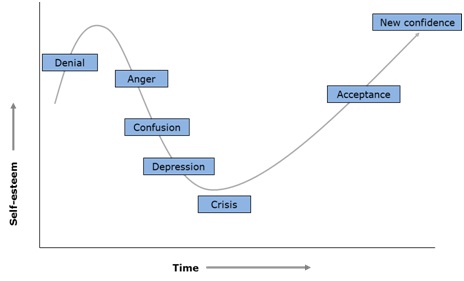Afraid of Change
Fear is the primary reason for resistance to change:
Indirect Change
Fear can also present itself in cases that involve indirect change, where the feeling of fear comes before the change. Case in point – Adelle is a college student required to complete a research paper. Although Adelle is an A student, she feels nervous and anxious about the assignment. In her words, she is “struggling” to complete the paper. When her coach questions her about her feelings, Adelle reveals that her father was overly critical of her when she was a young girl. She always felt that she was not “good enough.” As the coaching continued, Adelle realized that she was still carrying the old mindset of herself as a young girl. This mindset was causing her to doubt herself and her abilities now, 20 years later. Once Adelle became aware of this fact and questioned the validity of her old mindset, she embraced change and shifted her perspective.
Identity and Sense of Self
In addition, change can threaten one’s identity or sense of self, especially in employment related situations (Schuler, 2003). For example, those who are drawn to their work field because of their artistic abilities, such as draftsmen, may lose attraction for their work if their skills are replaced by computers. Career women who decide to leave their job to raise a family may vacillate between the warm feelings of motherhood and the feelings related to a loss of stature in their career. In these cases, the person’s sense of identity and self may be altered or threatened.
Embrace
 Embracing change is not only about accepting what life brings your way. It also means you are willing to look inside your self – to examine your thoughts, beliefs, and patterns of behavior. This can take great courage. Those who embrace change think of life as an adventure and an opportunity to discover more about themselves and the world in which they live. It can be argued that one never truly knows themselves unless he or she faces the challenges life provides.
Embracing change is not only about accepting what life brings your way. It also means you are willing to look inside your self – to examine your thoughts, beliefs, and patterns of behavior. This can take great courage. Those who embrace change think of life as an adventure and an opportunity to discover more about themselves and the world in which they live. It can be argued that one never truly knows themselves unless he or she faces the challenges life provides.
How do you know what you’re capable of if you don’t embrace the unknown? – Esmeralda Santiago
Coincidentally, inviting change into our lives can empower us and build new confidence and self-esteem. As you can see from the chart below, the more we embrace change, the more empowered we become. How would your life be different if you consciously embraced change?
Typical Path of Emotions during the Cycle of Change
 Neuroplasticity
Neuroplasticity
We must believe that we can make whatever changes we intend or our lack of conviction may keep us from reaching success. The theory of the Law of Attraction, which asserts that our thoughts create our reality, supports this premise. In addition, new discoveries in neuroscience have found that the brain can alter its structure. Scientists now know that our brains have the ability at any age to form new neural pathways in response to experience and repeated behaviors and information; this ability is referred to neuroplasticity. In effect, our thoughts have the capability to rewire our brains in a way that supports growth and change to manifest what we want to do and be in life (Schwartz, 2014).
Coaching is a way of creating self-directed neuroplasticity– Jeffrey Schwartz, neuroscientist
Story about Change
Embracing change is having the courage to take control over your life instead of just letting life happen. In the book, “Who Moved my Cheese,” the author examines the subject in a simple story about two mice and two small humans in a maze looking for cheese to convey different attitudes about change and how the attitudes impacted the lives of the characters in the story. The main principles of the book are (1) change happens; (2) anticipate change; (3) monitor change; (4) adapt to change quickly; (5) change; and (6) enjoy change. Once we accept that change is a normal condition of life, we can let go of fear and live life with a sense of fun and adventure (Johnson, 2002).